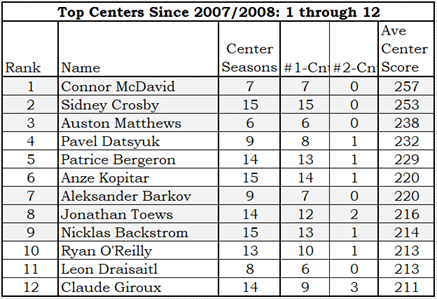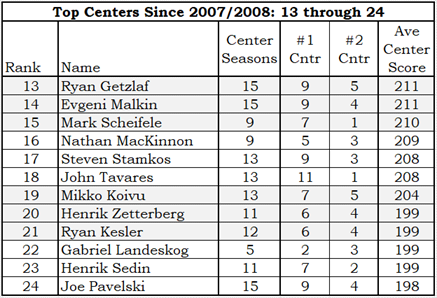In the article 2021/2022 Center Ratings I identified the top centers in hockey in the 2021/2022 season. In this article I’ll identify the top centers in hockey since the 2007/2008 season: not the players who have had the single best seasons in that time frame, but the ones who have consistently been at the top through all those seasons.
Rating Centers
The methodology used to rate centers was explained in the 2021/2022 article, but not in precise detail. I will use that same methodology. Two important criteria for being a center are games played in a season and faceoffs taken per game played.
Only players who played at least 20 games in a season will be considered as potential centers: adjustments will be made for seasons shortened by pandemic or lockout. This is an incredibly generous criterion, allowing many players who missed more than half a season to be considered.
Only players who take faceoffs at least 20% of the time will be considered centers. If a player was on the ice for 600 faceoffs and took 108 of them (18% of the faceoffs available), he’s a winger, not a center.
Categorizing Centers
Qualified players (20 games, 20%+ faceoff-taking) will have appropriate statistics churned through a formula that produces a numeric statistic (also known as an index) called CR-Score, which will be used to place a player into one of four CR-Categories.
Inventively, the CR-Categories are #1-Center, #2-Center, #3-Center and #4-Center. The best center is a #1-Center, just in case you were unsure.
“Since 2007/2008”
Looking at players over a significant period (15 years is a long time for hockey players) brings up a conflict. Some players have played all 15 seasons, most haven’t. How should the players be ranked? Using totaled statistics, the list will consist of nothing but the older players: this would be unfair to the recent players who are good centers (Auston Matthews, Connor McDavid, Sebastien Aho). Using averaged statistics, one-year-wonders, such as Jason Pominville, could rise to the top of the list.
Jason is a one-year-wonder at center because he only qualified as a center in one season: he was a #2-Center in 2011/2012. It was the only season he took more than 20% of the faceoffs he could have (22%).
I decided to use qualified average statistics. To qualify for consideration on this list, a player must have been qualified as a center in at least five seasons. This will exclude Sebastien Aho (Carolina forward) and Blake Wheeler from consideration, as they have yet to have five seasons where they qualified as a centre.
Centers Since 2007/2008 – Positions 1 Through 12

The top twelve are all outstanding centers who have maintained a level of excellence for a long time.
There are 2,839 instances of a player qualifying as a center since 2007/2008. In only 25 of those seasons did a player get a better CR-Score than McDavid’s average CR-Score (257).
In the first seven seasons of his career, Crosby’s average Center Score was 269.
Centers Since 2007/2008 – Positions 13 Through 24

The difference between #6 (Kopitar) and #18 (Tavares) is slim (12 CR-Score points). It is smaller than the gap between Crosby (2nd) and Matthews (3rd, 15 points behind Crosby). The top two players are the top two.
The older players in these lists would be ranked a little higher if the detailed statistics for the earlier parts of their careers existed.
Koivu and Pavelski wouldn’t move up much, as we’re only missing two seasons of detailed data from them (Actually, only one for Pavelski). The Henriks (Sedin and Zetterberg) are missing four and six seasons, but it is unlikely they would move up to the top twelve with a full set of data.
There are more than 24 players who have had five seasons where they qualified as a center. To see the 187 players whose career average score is greater than or equal to 140 (bottom of #3-Center category) please see the Best Centers Since 2007 Data List online at Stapled To The Bench.
Summary
The working description for a #1-Center is a player who takes a lot of faceoffs, takes faceoffs in the defensive zone, wins a lot of faceoffs, plays a lot during a game, kills penalties, scores, is “good with the puck”, and gets more shot attempts for his team than shot attempts against his team, and is a good player (has a good PR-Score). Not every #1-Center leads the league in each of those categories, but all #1-Centers does well in all categories, and does very well in some of them.
The best proof that the formula which categorizes centers works is the players it identifies as #1-Centers. In 2021/2022, 27 players were rated as #1-Centers. It is unlikely that anybody could argue with the top 20. This article identifies the 24 best centers since 2007/2008
Using the center-rating formula on all seasons for which we have the data, the best centers with 2007/2008 have been identified. Again, it would be hard to argue with the players who were identified at the top.
Extra Reading: Are Centers Born or Made?
Do players gradually increase their Center ratings at the early part of their career?
It is an interesting question: does a player who is a #2-Center and is early in his career have a reasonable shot at becoming a #1-Center? An example of a player who followed this pattern is Ryan O’Reilly. In his first two seasons he was a #3-Center, since then he has almost always been a #1-Center (10 times #1-Center, 1 time #2-Center).
The article titled “Progression of Centers” will investigate the career progression of centers. I felt it would be more appropriate to present those findings in an appropriately named article, instead of putting them in this one.
